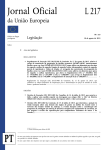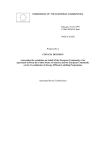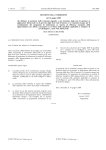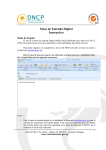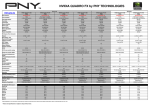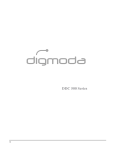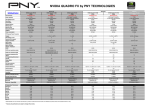Download V6.1 - EU ENERGY STAR
Transcript
18.8.2015
EN
Official Journal of the European Union
L 217/9
COMMISSION DECISION (EU) 2015/1402
of 15 July 2015
determining the European Union position with regard to a decision of the management entities
under the Agreement between the Government of the United States of America and the European
Union on the coordination of energy-efficiency labelling programmes for office equipment on the
revision of specifications for computers included in Annex C to the Agreement
(Text with EEA relevance)
THE EUROPEAN COMMISSION,
Having regard to the Treaty on the Functioning of the European Union,
Having regard to Council Decision 2013/107/EU of 13 November 2012 on the signing and conclusion of the
Agreement between the Government of the United States of America and the European Union on the coordination of
energy-efficiency labelling programmes for office equipment (1), and in particular Article 4 thereof,
Whereas:
(1)
The Agreement allows the European Commission, together with the United States Environmental Protection
Agency, to develop and periodically revise common specifications for office equipment, thereby amending Annex
C to the Agreement.
(2)
The position of the European Union with regard to the amendment of the specifications is to be determined by
the Commission.
(3)
The measures provided for in this Decision take account of the opinion given by the European Union Energy Star
Board referred to in Article 8 of Regulation (EC) No 106/2008 of the European Parliament and of the Council (2).
(4)
The specification for computers given in Part I of Annex C should be repealed and replaced by the specifications
annexed to this Decision,
HAS ADOPTED THIS DECISION:
Sole Article
The position to be adopted by the European Union with regard to a decision to be taken by the management entities
under the Agreement between the Government of the United States of America and the European Union on the
coordination of energy-efficiency labelling programmes for office equipment on revising the specifications for computers
given in Part I of Annex C to the Agreement shall be based on the attached draft decision.
This Decision shall enter into force on the twentieth day following that of its publication in the Official Journal of the
European Union.
Done at Brussels, 15 July 2015.
For the Commission
The President
Jean-Claude JUNCKER
(1) OJ L 63, 6.3.2013, p. 5.
(2) Regulation (EC) No 106/2008 of the European Parliament and of the Council of 15 January 2008 on a Community energy-efficiency
labelling programme for office equipment (OJ L 39, 13.2.2008, p. 1).
L 217/10
EN
Official Journal of the European Union
18.8.2015
ANNEX
DRAFT DECISION
of …
the Management entities under the Agreement between the Government of the United States of
America and the European Union on the coordination of energy-efficiency labelling programmes
for office equipment on the revision of specifications for computers included in Annex C of the
Agreement
THE MANAGEMENT ENTITIES,
Having regard to the Agreement between the Government of the United States and the European Union on the
coordination of energy-efficiency labelling programmes for office equipment, and in particular Article XII thereof,
Whereas specifications for ‘computers’ should be revised,
HAVE DECIDED AS FOLLOWS:
Part I ‘Computers’ currently included in Annex C of the Agreement between the Government of the United States and
the European Union on the coordination of energy-efficiency labelling programmes for office equipment shall be
replaced by Part V ‘Computers’ as laid down thereafter.
The Decision shall enter into force on the twentieth day following its publication. The Decision, done in duplicate, shall
be signed by the Co-chairs.
Signed in Washington DC on the […] […]
Signed in Brussels on the […] […]
on behalf of the United States Environmental
Protection Agency
on behalf of the European Union
18.8.2015
EN
Official Journal of the European Union
L 217/11
ANNEX
ANNEX C
PART II TO THE AGREEMENT
‘V. COMPUTER SPECIFICATIONS (VERSION 6.1)
1. Definitions
A. Product Types:
1. Computer: A device which performs logical operations and processes data. For the purposes of this specification,
computers include both stationary and portable units, including Desktop Computers, Integrated Desktop
Computers, Notebook Computers, Small-Scale Servers, Thin Clients, and Workstations. Although computers are
capable of using input devices and displays, such devices are not required to be included with the computer upon
shipment. Computers are composed of, at a minimum:
a) A central processing unit (CPU) to perform operations. If no CPU is present, then the device must function as
a client gateway to a server which acts as a computational CPU;
b) User input devices such as a keyboard, mouse, or touchpad; and
c) An Integrated Display screen and/or the ability to support an external display screen to output information.
2. Desktop Computer: A computer whose main unit is designed to be located in a permanent location, often on a
desk or on the floor. Desktop computers are not designed for portability and are designed for use with an
external display, keyboard, and mouse. Desktop computers are intended for a broad range of home and office
applications, including point of sale applications.
a) Integrated Desktop Computer: A Desktop Computer in which the computing hardware and display are
integrated into a single housing, and which is connected to ac mains power through a single cable. Integrated
Desktop Computers come in one of two possible forms: (1) a system where the display and computer are
physically combined into a single unit; or (2) a system packaged as a single system where the display is
separate but is connected to the main chassis by a dc power cord and both the computer and display are
powered from a single power supply. As a subset of Desktop Computers, Integrated Desktop Computers are
typically designed to provide similar functionality as Desktop systems.
3. Notebook Computer: A computer designed specifically for portability and to be operated for extended periods of
time both with and without a direct connection to an ac mains power source. Notebook Computers include an
Integrated Display, a non-detachable, mechanical keyboard (using physical, moveable keys), and pointing device.
Note: Notebook computers are typically designed to provide similar functionality to Desktops, including operation
of software similar in functionality as that used in Desktops. For purposes of this specification, Notebook
Computers include models with touch-sensitive screens.
a) Mobile Thin Client: A computer meeting the definition of a Thin Client, designed specifically for portability,
and also meeting the definition of a Notebook Computer. These products are considered to be Notebook
Computers for the purposes of this specification.
b) Two-In-One Notebook: A computer which resembles a traditional Notebook Computer with a clam shell
form factor, but has a detachable display which can act as an independent Slate/Tablet when disconnected.
The keyboard and display portions of the product must be shipped as an integrated unit. Two-In-One
Notebooks are considered Notebooks in the remainder of this specification and are therefore not referenced
explicitly.
4. Slate/Tablet: A computing device designed for portability that meets all of the following criteria:
a) Includes an integrated display with a diagonal size greater than 6,5 inches and less than 17,4 inches;
b) Lacking an integrated, physical attached keyboard in its as-shipped configuration;
L 217/12
EN
Official Journal of the European Union
18.8.2015
c) Includes and primarily relies on touchscreen input; (with optional keyboard);
d) Includes and primarily relies on a wireless network connection (e.g., Wi-Fi, 3G, LTE, etc.); and
e) Includes and is primarily powered by an internal battery (with connection to the mains for battery charging,
not primary powering of the device).
5. Portable All-In-One Computer: A computing device designed for limited portability that meets all of the following
criteria:
a) Includes an integrated display with a diagonal size greater than or equal to 17,4 inches;
b) Lacking keyboard integrated into the physical housing of the product in its as-shipped configuration;
c) Includes and primarily relies on touchscreen input; (with optional keyboard);
d) Includes wireless network connection (e.g. Wi-Fi, 3G, LTE, etc.); and
e) Includes an internal battery, but is primarily powered by connection to the ac mains.
6. E-Reader: A device designed for display and consumption of static images. The display is characterized by a low
refresh rate and a display made of bistable materials where no energy is needed to maintain a visible image, only
to alter the image.
7. Small-scale Server: A computer that typically uses desktop components in a desktop form factor, but is designed
primarily to be a storage host for other computers. Small-scale Servers are designed to perform functions such as
providing network infrastructure services (e.g., archiving) and hosting data/media. These products are not
designed to process information for other systems or run web servers as a primary function. A Small-scale Server
has the following characteristics:
a) Designed in a pedestal, tower, or other form factor similar to those of desktop computers such that all data
processing, storage, and network interfacing is contained within one box/product;
b) Designed to operate 24 hours/day, 7 days/week, with minimal unscheduled downtime (on the order of hours/
year);
c) Capable of operating in a simultaneous multi-user environment serving several users through networked client
units; and
d) Designed for an industry accepted operating system for home or low-end server applications (e.g., Windows
Home Server, Mac OS X Server, Linux, UNIX, Solaris).
8. Thin Client: An independently-powered computer that relies on a connection to remote computing resources
(e.g., computer server, remote workstation) to obtain primary functionality. Main computing functions
(e.g., program execution, data storage, interaction with other internet resources) are provided by the remote
computing resources. Thin Clients covered by this specification are (1) limited to devices with no rotational
storage media integral to the computer and (2) designed for use in a permanent location (e.g. on a desk) and not
for portability.
a) Integrated Thin Client: A Thin Client in which computing hardware and display are connected to ac mains
power through a single cable. Integrated Thin Client computers come in one of two possible forms: (1) a
system where the display and computer are physically combined into a single unit; or (2) a system packaged
as a single system where the display is separate but is connected to the main chassis by a dc power cord and
both the computer and display are powered from a single power supply. As a subset of Thin Clients,
Integrated Thin Clients are typically designed to provide similar functionality as Thin Client systems.
b) Ultra-thin Client: A computer with lesser local resources than a standard Thin Client that sends raw mouse
and keyboard input to a remote computing resource and receives back raw video from the remote computing
resource. Ultra-thin clients cannot interface with multiple devices simultaneously nor run windowed remote
applications due to the lack of a user-discernible client operating system on the device (i.e., beneath firmware,
user inaccessible).
18.8.2015
EN
Official Journal of the European Union
L 217/13
9. Workstation: A high-performance, single-user computer typically used for graphics, CAD, software development,
financial and scientific applications among other compute intensive tasks. Workstations covered by this specifi
cation (a) are marketed as a workstation; (b) provide mean time between failures (MTBF) of at least 15 000 hours
(based on either Bellcore TR-NWT-000332, issue 6, 12/97 or field collected data); and (c) support errorcorrecting code (ECC) and/or buffered memory. In addition, a workstation meets three or more of the following
criteria:
a) Provide supplemental power support for high-end graphics (e.g., PCI-E 6-pin 12V supplemental power feed);
b) Wired for greater than x4 PCI-E on the motherboard in addition to the graphics slot(s) and/or PCI-X support;
c) Do not provide support for Uniform Memory Access (UMA) graphics;
d) Provide 5 or more PCI, PCI-E, or PCI-X slots;
e) Provide multi-processor support for 2 or more processors (shall support physically separate processor
packages/sockets, i.e., requirement cannot be met with support for a single multi-core processor); and/or
f) Qualification by 2 or more Independent Software Vendor (ISV) product certifications; these certifications can
be in process, but shall be completed within 3 months of qualification.
B. Product Category: A second-order classification or sub-type within a product type that is based on product features
and installed components. Product categories are used in this specification to determine qualification and test
requirements.
C. Computer Components:
1. Graphics Processing Unit (GPU): An integrated circuit, separate from the CPU, designed to accelerate the
rendering of either 2D and/or 3D content to displays. A GPU may be mated with a CPU, on the system board of
the computer or elsewhere to offload display capabilities from the CPU.
2. Discrete Graphics (dGfx): A graphics processor (GPU) with a local memory controller interface and local
graphics-specific memory.
3. Integrated Graphics (iGfx): A graphics solution that does not contain Discrete Graphics.
4. Display: A commercially-available product with a display screen and associated electronics, often encased in a
single housing, that as its primary function displays visual information from (1) a computer, workstation or
server via one or more inputs (e.g., VGA, DVI, HDMI, DisplayPort, IEEE 1394, USB), (2) external storage (e.g.,
USB flash drive, memory card), or (3) a network connection.
a) Enhanced-performance Integrated Display: An integrated Computer Display that has all of the following
features and functionalities:
(1) A contrast ratio of at least 60:1 at a horizontal viewing angle of at least 85°, with or without a screen
cover glass;
(2) A native resolution greater than or equal to 2,3 megapixels (MP); and
(3) A colour gamut of at least sRGB as defined by European Standard EN 61966-2-1 (identical with IEC
61966-2-1). Shifts in colour space are allowable as long as 99 % or more of defined sRGB colours are
supported.
5. External Power Supply (EPS): Also referred to as External Power Adapter. An external power supply circuit that is
used to convert household electric current into dc current or lower-voltage ac current to operate a consumer
product.
L 217/14
EN
Official Journal of the European Union
18.8.2015
6. Internal Power Supply (IPS): A component internal to the computer casing and designed to convert ac voltage
from the mains to dc voltage(s) for the purpose of powering the computer components. For the purposes of this
specification, an internal power supply shall be contained within the computer casing but be separate from the
main computer board. The power supply shall connect to the mains through a single cable with no intermediate
circuitry between the power supply and the mains power. In addition, all power connections from the power
supply to the computer components, with the exception of a DC connection to a display in an Integrated
Desktop Computer, shall be internal to the computer casing (i.e., no external cables running from the power
supply to the computer or individual components). Internal dc-to-dc converters used to convert a single dc
voltage from an external power supply into multiple voltages for use by the computer are not considered internal
power supplies.
D. Operational Modes:
1. Active State: The power state in which the computer is carrying out useful work in response to a) prior or
concurrent user input or b) prior or concurrent instruction over the network. Active State includes active
processing, seeking data from storage, memory, or cache, including Idle State time while awaiting further user
input and before entering low power modes.
2. Idle State: The power state in which the operating system and other software have completed loading, a user
profile has been created, activity is limited to those basic applications that the system starts by default, and the
computer is not in Sleep Mode. Idle State is composed of two sub-states: Short Idle and Long Idle.
a) Long Idle: The mode where the Computer has reached an Idle condition (i.e., 15 minutes after OS boot or
after completing an active workload or after resuming from Sleep Mode) and the main Computer Display has
entered a low-power state where screen contents cannot be observed (i.e., backlight has been turned off) but
remains in the working mode (ACPI G0/S0). If power management features are enabled as-shipped in the
scenario described in this definition, such features shall engage prior to evaluation of Long Idle (e.g., display is
in a low power state, HDD may have spun-down), but the Computer is prevented from entering Sleep Mode.
PLONG_IDLE represents the average power measured when in the Long Idle Mode.
b) Short Idle: The mode where the Computer has reached an Idle condition (i.e., 5 minutes after OS boot or
after completing an active workload or after resuming from Sleep Mode), the screen is on, and Long Idle
power management features have not engaged (e.g. HDD is spinning and the Computer is prevented from
entering sleep mode). PSHORT_IDLE represents the average power measured when in the Short Idle mode.
3. Off Mode: The lowest power mode which cannot be switched off (influenced) by the user and that may persist
for an indefinite time when the appliance is connected to the main electricity supply and used in accordance with
the manufacturer's instructions. For systems where ACPI standards are applicable, Off Mode correlates to ACPI
System Level S5 state.
4. Sleep Mode: A low power mode that the computer enters automatically after a period of inactivity or by manual
selection. A computer with Sleep capability can quickly “wake” in response to network connections or user
interface devices with a latency of less than or equal to 5 seconds from initiation of wake event to system
becoming fully usable including rendering of display. For systems where ACPI standards are applicable, Sleep
Mode most commonly correlates to ACPI System Level S3 (suspend to RAM) state.
E. Networking and Additional Capabilities:
1. Additional Internal Storage: Any and all internal hard disk drives (HDD) or solid state drives (SSD) shipping with
a computer beyond the first. This definition does not include external drives.
2. Energy Efficient Ethernet (EEE): A technology which enables reduced power consumption of Ethernet interfaces
during times of low data throughput. Specified by IEEE 802.3az.
3. Full Network Connectivity: The ability of the computer to maintain network presence while in Sleep Mode or an
alternative low power mode (LPM) with power less than or equal to 10 watts and intelligently wake when further
processing is required (including occasional processing required to maintain network presence). Presence of the
computer, its network services and applications, is maintained even though the computer is in a LPM. From the
18.8.2015
EN
Official Journal of the European Union
L 217/15
vantage point of the network, a computer with full network connectivity that is in LPM is functionally equivalent
to an idle computer with respect to common applications and usage models. Full network connectivity in LPM is
not limited to a specific set of protocols but can cover applications installed after initial installation. Also referred
to as “network proxy” functionality and as described in the Ecma-393 standard.
a) Network Proxy — Base Capability: To maintain addresses and presence on the network while in LPM, the
system handles IPv4 ARP and IPv6 NS/ND.
b) Network Proxy — Full Capability: While in LPM, the system supports Base Capability, Remote Wake, and
Service Discovery/Name Services.
c) Network Proxy — Remote Wake: While in LPM, the system is capable of remotely waking upon request from
outside the local network. Includes Base Capability.
d) Network Proxy — Service Discovery/Name Services: While in LPM, the system allows for advertising host
services and network name. Includes Base Capability.
4. Network Interface: The components (hardware and software) whose primary function is to make the computer
capable of communicating over one or more network technologies. Examples of Network Interfaces are
IEEE 802.3 (Ethernet) and IEEE 802.11 (Wi-Fi).
5. Wake Event: A user, scheduled, or external event or stimulus that causes the computer to transition from Sleep
Mode or Off Mode to an active state of operation. Examples of wake events include, but are not limited to:
movement of the mouse, keyboard activity, controller input, real-time clock event, or a button press on the
chassis, and in the case of external events, stimulus conveyed via a remote control, network, modem, etc.
6. Wake On LAN (WOL): Functionality which allows a computer to transition from Sleep Mode or Off Mode to an
Active State of operation when directed by a network Wake Event via Ethernet.
7. Switchable Graphics: Functionality that allows Discrete Graphics to be disabled when not required in favour of
Integrated Graphics.
Note: This functionality allows lower power and lower capability integrated GPUs to render the display while on
battery or when the output graphics are not overly complex while then allowing the more power consumptive
but more capable discrete GPU to provide rendering capability when the user requires it.
F. Marketing and Shipment Channels:
1. Enterprise Channels: Sales channels typically used by large and medium-sized business, government, educational,
or other organizations to purchase computers for use in managed client/server environments.
2. Model Name: A marketing name that includes reference to the computer model number, product description, or
other branding references.
3. Model Number: A unique marketing name or identification reference that applies to a specific hardware and
software configuration (e.g., operating system, processor type, memory, GPU), and is either pre-defined or
selected by a customer.
G. Product Family: A high-level description referring to a group of computers sharing one chassis/motherboard
combination that often contains hundreds of possible hardware and software configurations. Product models within
a family differ from each other according to one or more characteristics or features that either (1) have no impact on
product performance with regard to ENERGY STAR qualification criteria, or (2) are specified herein as acceptable
variations within a product family. For Computers, acceptable variations within a product family include:
1. Colour;
2. Housing; and
3. Electronic components other than the chassis/motherboard, such as the processor, memory, GPU, etc.
L 217/16
EN
2.
Scope
2.1.
Included Products
Official Journal of the European Union
18.8.2015
2.1.1. Products that meet the definition of a Computer and one of the following Product Type definitions, as specified
herein, are eligible for ENERGY STAR qualification, with the exception of products listed in Section 2.2:
(i)
Desktop Computers and Integrated Desktop Computers;
(ii) Notebook Computers;
(iii) Slates/Tablets;
(iv) Portable All-In-One Computers;
(v)
Workstations;
(vi) Small-scale Servers that are marketed and sold for non-data centre use; and
(vii) Thin Clients.
2.2.
Excluded Products
2.2.1. Products that are covered under other ENERGY STAR product specifications are not eligible for qualification
under this specification. The list of specifications currently in effect can be found at www.energystar.gov/
products.
2.2.2. The following products are not eligible for qualification under this specification:
(i)
Docking Stations;
(ii)
Game Consoles;
(iii) E-Readers;
(iv)
Handheld gaming devices, typically battery powered and intended for use with an integral display as the
primary display;
(v)
Mobile Thin Clients not meeting the definition of Notebook Computer;
(vi)
Personal Digital Assistant devices (PDAs);
(vii) Point of Sale (POS) products that do not use internal components common to Notebook, Desktop, or
Integrated Desktop Computers, including processor, motherboard, and memory;
(viii) Small-scale Servers that are marketed and sold for use in data centres;
(ix) Handheld Computers which contain cellular voice capability;
(x)
Ultra-thin Clients.
3.
Qualification Criteria
3.1.
Significant Digits and Rounding
3.1.1. All calculations shall be carried out with directly measured (unrounded) values.
3.1.2. Unless otherwise specified in this specification, compliance with specification limits shall be evaluated using
directly measured or calculated values without any benefit from rounding.
3.1.3. Directly measured or calculated values that are submitted for reporting on the ENERGY STAR website shall be
rounded to the nearest significant digit as expressed in the corresponding specification limit.
18.8.2015
3.2.
Official Journal of the European Union
EN
L 217/17
General Requirements
3.2.1. Internal Power Supply (IPS) Requirements: IPSs used in Computers eligible under this specification must meet the
following requirements when tested using the Generalized Internal Power Supply Efficiency Test Protocol,
Rev. 6.6 (available at http://www.plugloadsolutions.com/docs/collatrl/print/Generalized_Internal_Power_Supply_
Efficiency_Test_Protocol_R6.6.pdf) and tested at the relevant input voltage/frequency combination for each
market in which they will be sold and promoted as ENERGY STAR..
(i) IPS with maximum rated output power less than 75 watts shall meet minimum efficiency requirements as
specified in Table 1.
(ii) IPS with maximum rated output power greater than or equal to 75 watts shall meet both minimum efficiency
requirements and minimum power factor requirements, as specified in Table 1.
Table 1
Requirements for Internal Power Supplies
Loading Condition
(Percentage of Nameplate Output Current)
Minimum Efficiency
Minimum Power Factor
20 %
0,82
—
50 %
0,85
—
100 %
0,82
0,90
3.2.2. External Power Supply (EPS) Requirements: Single- and Multiple-voltage EPSs shall meet the Level V or greater
performance requirements under the International Efficiency Marking Protocol when tested according to the
Uniform Test Method for Measuring the Energy Consumption of External Power Supplies, Appendix Z to 10 CFR
Part 430.
— Single-voltage EPSs shall include the Level V (or greater) marking.
— Additional information on the Marking Protocol is available at www.energystar.gov/powersupplies
3.3.
Power Management Requirements
3.3.1. Products shall include power management features in their “as-shipped” condition as specified in Table 2, subject
to the following conditions:
(i)
For Thin Clients, the Wake-on-LAN (WOL) requirement shall apply for products designed to receive software
updates from a centrally managed network while in Sleep Mode or in Off Mode. Thin Clients whose
standard software upgrade framework does not require off-hours scheduling are exempt from the WOL
requirement.
(ii) For Notebooks, WOL may be automatically disabled when the product is disconnected from ac mains power.
(iii) For all products with WOL, directed packet filters shall be enabled and set to an industry standard default
configuration.
(iv) Products that do not support Sleep Mode by default are only subject to the Display Sleep Mode requirement.
L 217/18
Official Journal of the European Union
EN
18.8.2015
Table 2
Mode or
Mode
Transition
Requirement
Desktops
Integrated Desktops
Portable All-In-Ones
Notebooks
Small-scale Servers
Slates=Tablets
Thin Clients
Workstations
Power Management Requirements
System
Sleep
Mode (1)
(1) Sleep Mode shall be set to activate after no more
than 30 minutes of user inactivity.
(2) The speed of any active 1 Gb/s Ethernet network
links shall be reduced when transitioning to
Sleep Mode or Off Mode.
Yes
Yes
Yes
Yes
No
N/A
Yes
Yes
Display
Sleep
Mode
Display Sleep Mode shall be set to activate after no
more than 15 minutes of user inactivity.
Yes
Yes
Yes
Yes
Yes
Yes
Yes
Yes
(1) Computers with Ethernet capability shall provide
users with an option to enable and disable WOL
for Sleep Mode.
(2) Computers with Ethernet capability that are
shipped through enterprise channels shall either:
Wake on
(a) be shipped with WOL enabled by default for
LAN
Sleep Mode, when the computer is operating
1
(WOL) ( )
on ac mains power; or
(b) provide users with the ability to enable WOL
that is accessible from both the client operat
ing system user interface and over the
network.
Yes
Yes
Yes
Yes
Yes
N/A
Yes
Yes
Computers with Ethernet capability that are shipped
through enterprise channels shall:
(a) be capable of both remote (via network) and
scheduled (via real-time clock) wake events from
Sleep Mode, and
(b) provide clients with the ability to centrally man
age (via vendor tools) any wake management set
tings that are configured through hardware set
tings if the manufacturer has control over such
features.
Yes
Yes
Yes
Yes
Yes
N/A
Yes
Yes
Wake
Management (1)
(1) Where Sleep Mode is supported by the UUT by default and Sleep Mode power is used as part of the TEC equation for qualification.
3.4.
User Information Requirements
3.4.1. Products shall be shipped with informational materials to notify customers of the following:
(i)
A description of power management settings that have been enabled by default,
18.8.2015
EN
Official Journal of the European Union
L 217/19
(ii) A description of the timing settings for various power management features, and
(iii) Instructions for properly waking the product from Sleep Mode.
3.4.2. Products shall be shipped with one or more of the following:
(i)
A list of default power management settings.
(ii) A note stating that default power management settings have been selected for compliance with ENERGY
STAR (within 15 min of user inactivity for the display, within 30 min for the computer, if applicable per
Table 2), and are recommended by the ENERGY STAR program for optimal energy savings.
(iii) Information about ENERGY STAR and the benefits of power management, to be located at or near the
beginning of the hard copy or electronic user manual, or in a package or box insert.
3.4.3. Provisions 3.4.1 and 3.4.2 may be met through use of either electronic or printed product documentation,
provided it adheres to all of the following:
(i) Documentation is shipped with the product (e.g., in a printed manual or insert, on included optical media, in
a file installed with the software load shipped to the customer) or available electronically on the manufac
turer's website. In the latter case, instructions for accessing the information on the website shall be provided
in the product package or on the Desktop or home screen; and
(ii) Documentation is included either (a) only with ENERGY STAR qualified Computers; or (b) as part of the
standard documentation if and only if accompanied by EPA-approved customer guidance on how to identify
if their computer configuration is ENERGY STAR qualified.
3.5.
Requirements for Desktop, Integrated Desktop, and Notebook Computers
3.5.1. Calculated Typical Energy Consumption (ETEC) for Desktop, Integrated Desktop, and Notebook Computers per
Equation 1 shall be less than or equal to the maximum TEC requirement (ETEC_MAX) per Equation 2, subject to the
following requirements:
(i)
The Additional Internal Storage adder allowance (TECSTORAGE) shall be applied if there are more than one
internal storage devices present in the product, in which case it shall only be applied once.
(ii) The Integrated Display adder allowance (TECINT_DISPLAY) applies only for Integrated Desktops and Notebooks
and may be applied for each display. For Enhanced-performance Integrated Displays, the adder is calculated
as presented in Table 7 and Equation 3.
(iii) For a product to qualify for the Full Network Connectivity mode weightings, the following criteria shall be
satisfied:
— Products shall meet a non-proprietary Full Network Connectivity standard such as ECMA 393 or another
standard that has been approved by EPA or the European Commission as meeting the goals of ENERGY
STAR. Such approval must be in place prior to submittal of product data for qualification.
— Products shall have the applied level of functionality enabled and configured by default upon
shipment. If Full Network Connectivity features are not enabled by default, the system shall be tested
and reported with Conventional TEC weightings.
— Products shall be capable of Sleep Mode or alternative low power modes with power less than or
equal to 10 watts.
— Note: Full Network Connectivity is a manufacturer-reported parameter. On Mac computers, “Wake for
network access” enabled within the Energy Saver/Power Adapter Preferences signifies Base Capability or
better. On Windows computers, “ARP Offload” or “NS Offload” or similar enabled within the Advanced
Properties of the Network Interface Card (accessed through the Device Manager) signifies Base Capability
or better. For systems with a dual Network Interface Card (NIC) configuration, only one NIC configur
ation needs to comply. The manufacturer can provide further guidance on how to confirm Proxy
Support.
L 217/20
Official Journal of the European Union
EN
18.8.2015
(iv) For Notebooks, Desktops, and Integrated Desktops that use an alternative low power mode in place of
System Sleep Mode, power in Long Idle (PLONG_IDLE) may be used in place of power in Sleep (PSLEEP)
in Equation 1 if the alternative low power mode is less than or equal to 10 watts. In such instances,
(PSLEEP × TSLEEP), is replaced by (PLONG_IDLE × TSLEEP); Equation 1 remains otherwise unchanged.
(v) Notebooks, Desktops, and Integrated Desktops with switchable graphics may not apply the Discrete Graphics
allowance, TECGRAPHICS, from Table 7 in Equation 2. However, for Desktop and Integrated Desktop systems
providing Switchable Graphics and enabling it by default, an allowance equal to 50 % of the G1 graphics
allowance for the platform type (Desktop or Integrated Desktop) may be applied. The switchable graphics
incentive only applies to automated switching that is enabled by default. This capability is manufacturerdeclared.
Equation 1: TEC Calculation (ETEC) for Desktop, Integrated Desktop, Thin Client and Notebook Computers
ETEC ¼ 8 760 � ðPOFF � TOFF þ PSLEEP � TSLEEP þ PLONG_IDLE � TLONG_IDLE þ PSHORT_IDLE � TSHORT_IDLE Þ
1 000
Where:
— POFF = Measured power consumption in Off Mode (W);
— PSLEEP = Measured power consumption in Sleep Mode (W);
— PLONG_IDLE = Measured power consumption in Long Idle Mode (W);
— PSHORT_IDLE = Measured power consumption in Short Idle Mode (W); and
— TOFF, TSLEEP, TLONG_IDLE, and TSHORT_IDLE are mode weightings as specified in Table 3 (for Desktops, Integrated
Desktops, and Thin Clients) or Table 4 (for Notebooks).
Table 3
Mode Weightings for Desktop, Thin Clients, and Integrated Desktop Computers
Full Network Connectivity
Mode Weighting
Conventional (%)
Base Capability
(%)
Remote Wake (%)
Service Discovery/
Name Services (%)
Full Capability (%)
TOFF
45
40
30
25
20
TSLEEP
5
15
28
36
45
TLONG_IDLE
15
12
10
8
5
TSHORT_IDLE
35
33
32
31
30
Table 4
Mode Weightings for Notebook Computers
Full Network Connectivity
Mode Weighting
Conventional (%)
Base Capability
(%)
Remote Wake (%)
Service Discovery/
Name Services (%)
Full Capability (%)
TOFF
25
25
25
25
25
TSLEEP
35
39
41
43
45
18.8.2015
Official Journal of the European Union
EN
L 217/21
Full Network Connectivity
Mode Weighting
Conventional (%)
Base Capability
(%)
Remote Wake (%)
Service Discovery/
Name Services (%)
Full Capability (%)
TLONG_IDLE
10
8
7
6
5
TSHORT_IDLE
30
28
27
26
25
Equation 2: ETEC_MAX Calculation for Desktop, Integrated Desktop, and Notebook Computers
ETEC_MAX = (1 + ALLOWANCEPSU) × (TECBASE + TECMEMORY + TECGRAPHICS + TECSTORAGE + TECINT_DISPLAY + TECSWITCHABLE + TECEEE)
Where:
— ALLOWANCEPSU is an allowance provided to power supplies that meet the optional more stringent efficiency
levels specified in Table 5; power supplies that do not meet the requirements receive an allowance of 0;
— TECBASE is the Base allowance specified in Table 6; and,
— TECGRAPHICS is the discrete graphics allowance as specified in Table 7, with the exception of systems with
integrated graphics, which do not receive an allowance, or Desktops and Integrated Desktops with switchable
graphics enabled by default, which receive an allowance through TECSWITCHABLE; and
— TECMEMORY, TECSTORAGE, TECINT_DISPLAY, TECSWITCHABLE, and TECEEE are adder allowances as specified in Table 7.
Table 5
Power Supply Efficiency Allowance
Power
Supply
Type
Computer Type
Minimum Efficiency at Specified Proportion of
Rated Output Current (1)
Minimum Average
Efficiency (2)
AllowancePSU
10 %
20 %
50 %
100 %
0,81
0,85
0,88
0,85
—
0,015
0,84
0,87
0,90
0,87
—
0,03
0,81
0,85
0,88
0,85
—
0,015
0,84
0,87
0,90
0,87
—
0,04
0,83
—
—
—
0,88
0,015
0,84
—
—
—
0,89
0,03
0,83
—
—
—
0,88
0,015
0,84
—
—
—
0,89
0,04
Desktop
IPS
Integrated
Desktop
Notebook or
Desktop
EPS
Integrated
Desktop
(1) EPSs shall meet the specified requirements when tested using the Uniform Test Method for Measuring the Energy Consump
tion of External Power Supplies, Appendix Z to 10 CFR Part 430. IPSs shall meet the specified requirements when tested
using the EPRI 306 Generalized Internal Power Supply Efficiency Test Protocol, Rev. 6.6.
(2) Average efficiency is the arithmetic mean of efficiencies tested at 25 %, 50 %, 75 %, and 100 % of rated output current.
EPSs shall meet the specified requirements when tested using the Uniform Test Method for Measuring the Energy Consump
tion of External Power Supplies, Appendix Z to 10 CFR Part 430.
L 217/22
Official Journal of the European Union
EN
18.8.2015
Table 6
Base TEC (TECBASE) Allowances
Desktop or Integrated Desktop
Cat
egory
Name
Graphics Capability (1)
0
Any Graphics
Notebook
Performance Score,
P (2)
Base Allowance
Performance Score,
Pv
Base Allowance
P≤3
69,0
P≤2
14,0
3<P≤6
112,0
2 < P ≤ 5,2
22,0
6<P≤7
120,0
5,2 < P ≤ 8
24,0
P>7
135,0
P>8
28,0
dGfx ≤ G7
I1
I2
Integrated or
Switchable Graphics
I3
D1
Discrete Graphics
3<P≤9
115,0
2<P≤9
16,0
D2
dGfx ≤ G7
P>9
135,0
P>9
18,0
(1) Discrete Graphics capability is categorized based on frame buffer bandwidth, as shown in Table 7.
(2) P = [# of CPU cores] × [CPU clock speed (GHz)], where # of cores represents the number of physical CPU cores and CPU
clock speed represents the Max TDP core frequency, not the turbo boost frequency.
Table 7
Functional Adder Allowances for Desktop, Integrated Desktop, Thin Client, and Notebook Computers
Function
Desktop
Integrated Desktop
TECMEMORY (kWh) (1)
TECGRAPHICS
(kWh) (2)
G1
Notebook
0,8
36
14
51
20
64
26
83
32
105
42
115
48
130
60
(FB_BW ≤ 16)
G2
(16< FB_BW ≤ 32)
G3
Graphics Category (3 )
(32 < FB_BW ≤ 64)
G4
(64 < FB_BW ≤ 96)
G5
(96 < FB_BW ≤ 128)
G6
(FB_BW > 128;
Frame Buffer Data
Width < 192 bits)
G7
(FB_BW > 128;
Frame Buffer Data
Width ≥ 192 bits
18.8.2015
Official Journal of the European Union
EN
Function
Desktop
Integrated Desktop
L 217/23
Notebook
TECSWITCHABLE (kWh) (4)
0,5 × G1
N/A
TECEEE (kWh) (5)
8,76 × 0,2 × (0,15 + 0,35)
8,76 × 0,2 × (0,10 + 0,30)
TECSTORAGE (kWh) (6)
26
2,6
TECINT_DISPLAY (kWh) (7)
N/A
8,76 × 0,35 × (1 + EP) ×
(4 × r + 0,05 × A)
8,76 × 0,30 × (1 + EP)
× (2 × r + 0,02 × A)
(1) TECMEMORY Adder: Applies per GB installed in the system.
(2) TECGRAPHICS Adder: Applies to only the first dGfx installed in the system, but not Switchable Graphics.
(3) FB_BW: Is the display frame buffer bandwidth in gigabytes per second (GB/s). This is a manufacturer declared parameter
and should be calculated as follows: (Data Rate [Mhz] × Frame Buffer Data Width [bits])/(8 × 1 000)
(4) TECSWITCHABLE Incentive: Applies to automated switching that is enabled by default in Desktops and Integrated Desktops.
(5) TECEEE: Applies per IEEE 802.3az-compliant (Energy Efficient Ethernet) Gigabit Ethernet port.
(6) TECSTORAGE Adder: Applies once if system has more than one Additional Internal Storage element.
(7) TECINT_DISPLAY Adder: EP is the Enhanced Performance Display allowance calculated per Equation 3; r is the Screen resolution
in megapixels; and A is viewable screen area in square inches.
Equation 3: Calculation of Allowance for Enhanced-performance Integrated Displays
8
0,
No Enhanced Performance Display
>
>
>
>
>
<
EP =
0,3, Enhanced Performance Display, d < 27
>
>
>
>
>
:
0,75, Enhanced Performance Display, d ≥ 27
Where:
— d is the diagonal of the screen, in inches;
3.6.
Requirements for Slates/Tablets and Portable All-In-One Computers
3.6.1. Slates/Tablets shall follow all of the requirements for Notebook Computers in Section 3.5 above, including
calculations of the following:
(i) Calculated Typical Energy Consumption (ETEC), using Equation 1 with the Notebook Computer Mode
Weightings from Table 4.
(ii) Calculated Maximum Allowed Typical Energy Consumption (ETEC_MAX), using Equation 2 with the appropriate
base Notebook Computer allowance from Table 6, and applicable Notebook Computer functional adder
allowances from Table 7.
3.6.2. Portable All-In-One Computers shall follow all of the requirements for Integrated Desktop Computers in Section
3.5 above, including calculation of the following:
(i) Calculated Typical Energy Consumption (ETEC), using Equation 1 with the Integrated Desktop Computer Mode
Weightings from Table 3.
(ii) Calculated Maximum Allowed Typical Energy Consumption (ETEC_MAX), using Equation 2 with the appropriate
base Integrated Desktop Computer allowance from Table 6, and applicable Integrated Desktop Computer
functional adder allowances from Table 7.
Note: EPA and the European Commission intend to further evaluate Slate/Tablet and Portable All-In-One Computer
product data to inform the development of future energy consumption requirements.
L 217/24
3.7.
Official Journal of the European Union
EN
18.8.2015
Requirements for Workstations
3.7.1. Weighted power consumption (PTEC) as calculated per Equation 4 shall be less than or equal to the maximum
weighted power consumption requirement (PTEC_MAX) as calculated per Equation 5.
Equation 4: PTEC Calculation for Workstations
PTEC = POFF × TOFF + PSLEEP × TSLEEP + PLONG_IDLE× TLONG_IDLE + PSHORT_IDLE × TSHORT_IDLE
Where:
— POFF = Measured power consumption in Off Mode (W);
— PSLEEP = Measured power consumption in Sleep Mode (W);
— PLONG_IDLE = Measured power consumption in Long Idle Mode (W);
— PSHORT_IDLE = Measured power consumption in Short Idle Mode (W); and
— TOFF, TSLEEP, TLONG_IDLE, and TSHORT_IDLE are mode weightings as specified in Table 8
Table 8
Mode Weightings for Workstations
TOFF
TSLEEP
TLONG_IDLE
TSHORT_IDLE
35 %
10 %
15 %
40 %
Equation 5: PTEC_MAX Calculation for Workstations
PTEC_MAX = 0,28×(PMAX + NHDD × 5) + 8,76×PEEE × (TSLEEP + TLONG_IDLE + TSHORT_IDLE)
Where:
— PMAX = Measured maximum power consumption (W)
— NHDD = Number of installed hard disk drives (HDD) or solid state drives (SSD)
— PEEE is an EEE allowance of 0,2 W per IEEE 802.3az-compliant (Energy Efficient Ethernet) Gigabit Ethernet
port.
3.7.2. Active State Benchmark: To be ENERGY STAR qualified, a Workstation must be submitted for qualification with
the following information disclosed in full:
(i) Linpack benchmark test results, compiler optimizations, and total energy consumed over the duration of the
test; and
(ii) SPECviewperf benchmark test results, configuration options, total duration of the test, and total energy
consumed over the duration of the test.
3.7.3. Desktop Workstations: Products marketed as workstations may be ENERGY STAR qualified under the Desktop
requirements in Section 3.5 instead of the Workstation requirements in Section 3.6, at the Partner's option. EPA
or the European Commission will identify Workstations qualified as Desktops as “Desktops” in all ENERGY STAR
marketing materials, on qualified product lists, etc.
18.8.2015
3.8.
Official Journal of the European Union
EN
L 217/25
Requirements for Small-scale Servers
3.8.1. Measured Off Mode power (POFF) shall be less than or equal to the Maximum Off Mode Power Requirement
(POFF_MAX), as calculated per Equation 6, subject to the following requirements:
(i) The Off Mode Wake-on-LAN (WOL) adder allowance (POFF_WOL) shall only be applied to products that offer
WOL enabled by default upon shipment.
Equation 6: Calculation of POFF_MAX for Small-scale Servers
POFF_MAX = POFF_BASE + POFF_WOL
Where:
— POFF_BASE is the base allowance as specified in Table 9; and
— POFF_WOL is the Wake-on-LAN allowance as specified in Table 9.
Table 9
Off Mode Power Allowances for Small-scale Servers
POFF_BASE
(watts)
POFF_WOL
(watts)
1,0
0,4
3.8.2. Measured Long Idle State power (PLONG_IDLE) shall be less than or equal to the Maximum Idle State Power
Requirement (PIDLE_MAX), as calculated per Equation 7.
Equation 7: Calculation of PIDLE_MAX for Small-scale Servers
PIDLE_MAX = PIDLE_BASE + (N – 1) × PIDLE_HDD + PEEE
Where:
— N is equal to the number of installed storage devices in the Small Scale Server (either hard disk drives or solid
state drives);
— PIDLE_BASE is the base allowance as specified in Table 10;
— PIDLE_HDD is the hard drive allowance as specified in Table 10; and
— PEEE is an EEE allowance of 0,2 W per IEEE 802.3az-compliant (Energy Efficient Ethernet) Gigabit Ethernet
port.
Table 10
Idle Mode Power Allowances for Small-scale Servers
PIDLE_BASE
(watts)
PIDLE_HDD
(watts)
24,0
8,0
L 217/26
3.9.
Official Journal of the European Union
EN
18.8.2015
Requirements for Thin Clients
3.9.1. Calculated Typical Energy Consumption (ETEC) per Equation 1 shall be less than or equal to the Maximum TEC
Requirement (ETEC_MAX), as calculated per Equation 8, subject to the following requirements.
(i)
Allowances can only be applied if the corresponding adders are enabled by default.
(ii) Thin Clients can utilize the proxy weightings in Table 3 when calculating ETEC.
(iii) For Thin Clients that lack a discrete System Sleep Mode, Long Idle State power (PLONG_IDLE) may be used in
place of Sleep Mode Power (PSLEEP) in Equation 1 so long as the system meets the Thin Client TEC allowance.
In such instances, (PSLEEP × TSLEEP), is replaced by (PLONG_IDLE × TSLEEP); Equation 1 remains otherwise unchanged.
Equation 8: Calculation of ETEC_MAX for Thin Clients
ETEC_MAX = TECBASE + TECGRAPHICS + TECWOL + TECINT_DISPLAY + TECEEE
Where:
— TECBASE is the Base Allowance specified in Table 11;
— TECGRAPHICS is the Discrete Graphics allowance specified in Table 11 if applicable;
— TECWOL is the Wake-on-LAN allowance specified in Table 11 if applicable;
— TECINT_DISPLAY is the Integrated Display allowance for Integrated Desktops specified in Table 7 if applicable; and
— TECEEE is the Energy Efficiency Ethernet incentive for Desktops specified in Table 7 if applicable, per
IEEE 802.3az-compliant (Energy Efficient Ethernet) Gigabit Ethernet port.
Table 11
Adder Allowances for Thin Clients
4.
Testing
4.1.
Test Methods
Adder
Allowance
(kWh)
TECBASE
60
TECGRAPHICS
36
TECWOL
2
4.1.1. For products placed on the market of the European Union manufacturers are required to perform tests and selfcertify those models that meet ENERGY STAR guidelines. When testing Computer products, the test methods
identified in Table 12 shall be used to determine ENERGY STAR qualification.
18.8.2015
EN
Official Journal of the European Union
L 217/27
Table 12
Test Methods for ENERGY STAR Qualification
4.2.
Product Type or
Component
Test Method
All
ENERGY STAR Test Method for Computers, Rev. August-2014
Number of Units Required for Testing
4.2.1. Representative Models shall be selected for testing per the following requirements:
(i)
For qualification of an individual product configuration, the unique configuration that is intended to be
marketed and labelled as ENERGY STAR is considered the Representative Model.
(ii) For qualification of a Product Family of all product types, with the exception of Workstations, product
configurations that represent the worst-case power consumption for each product category within the family
are considered Representative Models. When submitting Product Families, manufacturers continue to be held
accountable for any efficiency claims made about their products, including those not tested or for which data
were not reported.
(iii) For systems that meet the definition for multiple categories (as defined in Section 1.B) depending on the
specific configuration, manufacturers will have to submit the highest power configuration for each category
under which they would like the system to be ENERGY STAR qualified. For example, a system that could be
configured as either a Category 0 or 1 Desktop, as defined in Table 6 would require submittal of the highest
power configuration for both categories in order to be ENERGY STAR qualified. If a product could be
configured to meet all categories, it would then have to submit data for the highest power configuration in
all categories.
(iv) For qualification of a Product Family of Workstations under the Workstation or Desktop product type, the
product configuration that represents the worst-case power consumption with a single GPU within the
family is considered the Representative Model.
Note: Workstations that meet ENERGY STAR requirements with a single graphics device may also have a con
figuration with more than one graphics device be ENERGY STAR qualified, provided the additional hardware con
figuration is identical with the exception of the additional graphics device(s). The use of multiple graphics
includes, but is not limited to, driving multiple displays and ganging for high performance, multi-GPU config
urations (e.g. ATI Crossfire, NVIDIA SLI). In such cases, and until such time as SPECviewperf® supports multiple
graphics threads, manufacturers may submit the test data for the workstation with the single graphics device for
both configurations without retesting the system.
4.2.2. A single unit of each Representative Model shall be selected for testing.
4.2.3. All units/configurations for which a Partner is seeking ENERGY STAR qualification, must meet the ENERGY
STAR requirements. However, if a Partner wishes to qualify configurations of a model for which non-ENERGY
STAR qualified alternative configurations exist, the Partner must assign the qualified configurations an identifier
in the model name/number that is unique to ENERGY STAR qualified configurations. This identifier must be used
consistently in association with the qualified configurations in marketing/sales materials and on the ENERGY
STAR list of qualified products (e.g. model A1234 for baseline configurations and A1234-ES for ENERGY STAR
qualified configurations).
Note: There may be cases—as described in the paragraph above—where not all units/configurations will meet
ENERGY STAR requirements. If so, the worst-case configuration for test will be the worst-case qualified configur
ation, and not one of the presumably even higher-energy consuming non-qualified configurations.
L 217/28
4.3.
EN
Official Journal of the European Union
18.8.2015
International Market Qualification
4.3.1. Products shall be tested for qualification at the relevant input voltage/frequency combination for each market in
which they will be sold and promoted as ENERGY STAR.
4.4.
Customer Software and Management Service Pre-Provisioning
4.4.1. If a manufacturing Partner is hired by a customer to load a custom image on an ENERGY STAR qualified
computer, the Partner shall take the following steps:
(i) Inform the customer that their product may not meet ENERGY STAR with the custom image. A sample
notification letter is available on the ENERGY STAR Web site.
(ii) Encourage the customer to test the product for ENERGY STAR compliance.
5.
User Interface
5.1.1. Manufacturers are encouraged to design products in accordance with the user interface standard IEEE 1621:
Standard for User Interface Elements in Power Control of Electronic Devices Employed in Office/Consumer
Environments. For details, see http://eetd.LBL.gov/Controls.
6.
Effective Date
6.1.1. The date that manufacturers may begin to qualify products as Energy Star under this Version 6.1, will be defined
as the effective date of the Agreement. To be ENERGY STAR qualified, a product model shall meet the ENERGY
STAR specification in effect on its date of manufacture. The date of manufacture is specific to each unit and is the
date on which a unit is considered to be completely assembled.
6.1.2. Future Specification Revisions: EPA and the European Commission reserves the right to change this specification
should technological and/or market changes affect its usefulness to consumers, industry, or the environment. In
keeping with current policy, revisions to the specification are arrived at through stakeholder discussions. In the
event of a specification revision, please note that the ENERGY STAR qualification is not automatically granted for
the life of a product model.
Appendix A
SAMPLE CALCULATIONS
I.
Desktop, Integrated Desktop, Notebook Computers: Below is a sample TEC calculation intended to show how
levels for compliance are determined based on functional adders and operational mode measurements.
Following is a sample ETEC evaluation for a 2,0 GHz, dual core Notebook with Switchable Graphics, 8 GB Memory,
Energy Efficient Ethernet (EEE), and 1 hard disk drive (HDD).
A. Measure values using the ENERGY STAR Computers Test Method:
(1) Off Mode = 1,0 W
(2) Sleep Mode = 1,7 W
(3) Long Idle State = 8,0 W
(4) Short Idle State = 10,0 W
18.8.2015
Official Journal of the European Union
EN
L 217/29
B. Determine the proxy support provided by the operating system and network card. This is a manufacturerreported parameter.
(1) On Mac computers, “Wake for network access” enabled within the Energy Saver/Power Adapter Preferences
signifies Base Capability or better.
(2) On Windows computers, “ARP Offload” or “NS Offload” or similar enabled within the Advanced Properties
of the Network Interface Card (accessed through the Device Manager) signifies Base Capability or better. OEM
can provide further guidance on how to confirm Proxy Support
C. Calculate ETEC from power measurements and mode weightings—this example assumes no Proxy Support/
Conventional Weightings:
(1) ETEC ¼
TOFF
25 %
TSLEEP
35 %
TLONG_IDLE
10 %
TSHORT_IDLE
30 %
8 760
� ðPOFF � TOFF þ PSLEEP � TSLEEP þ PLONG_IDLE � TLONG_IDLE þ PSHORT_IDLE � TSHORT_IDLE Þ
1 000
(2) ETEC ¼ 8 760 � ð1,0 W � 25 % þ 1,7 W � 35 % þ 8,0 W � 10 % þ 10,0 W � 30 %Þ
1 000
(3) ETEC = 40,7 kWh/year
D. Determine which Base TEC allowance applies based on graphics capability and performance score: P = [# of CPU
cores] × [CPU clock speed (GHz)] = 2×2 GHz = 4.
Table 6
Base TEC (TECBASE) Allowances
Notebook
Category Name
I1
Graphics Capability
Integrated or Switchable Graphics
Performance Score, P
Base Allowance
2 < P ≤ 5,2
22,0
E. Determine which Functional Adder Allowances apply:
(1) Memory: 8 GB installed, so a TECMEMORY allowance of 8 GB � 0,8 kWh ¼ 6,4 kWh applies
GB
(2) Discrete Graphics? No, therefore TECGRAPHICS allowance does not apply.
(3) Switchable Graphics? Yes, but TECSWITCHABLE allowance does not apply to Notebooks.
(4) Energy Efficient Ethernet (EEE)? Yes, and assuming one EEE-compliant Ethernet port, a TECEEE allowance of
8,76 × 0,2 × (0,10 + 0,30) = 0,7 kWh applies
L 217/30
Official Journal of the European Union
EN
18.8.2015
(5) Storage? No, the notebook has only one hard disk drive, so no storage allowance applies.
(6) Integrated Display? Yes, and assuming a non-enhanced performance, 14 inch display with an area of 83,4 square
inches and a resolution of 1,05 megapixels, a TECINT_DISPLAY allowance of 8,76 × 0,30 × (1 + EP) × (2 ×
r + 0,02×A) = 8,76 × 0,30 × (2 × 1,05 MP + 0,02×83,4 in2) = 9,9 kWh applies.
F. Calculate ETEC_MAX:
(1) ETEC_MAX = 22,0 kWh + 6,4 kWh + 0,7 kWh + 9,9 kWh
(2) ETEC_MAX = 39,0 kWh/yr
G. Compare ETEC to the ETEC_MAX to determine if the model qualifies:
40,7 kWh/yr > 39,0 kWh/yr
Therefore, the Notebook does not meet ENERGY STAR requirements.
II. Workstations: Below is a sample PTEC calculation for a Workstation with 2 hard drives and no Energy Efficient
Ethernet capability.
A. Measure values using the ENERGY STAR Computers Test Method:
(1) Off Mode = 2 W
(2) Sleep Mode = 4 W
(3) Long Idle State = 50 W
(4) Short Idle State = 80 W
(5) Max Power = 180 W
B. Note number of Hard Drives installed: Two hard drives installed during test.
C. Calculate PTEC from power measurements and mode weightings using Equation 4:
TOFF
TSLEEP
TLONG_IDLE
TSHORT_IDLE
35 %
10 %
15 %
40 %
(1) PTEC = (35 % × POFF + 10 % × PSLEEP + 15 % × PLONG_IDLE + 40 % × PSHORT_IDLE)
(2) PTEC = (35 % × 2 W + 10 % × 4 W + 15 % × 50 W + 40 % × 80 W)
(3) PTEC = 40,6 W
D. Calculate the PTEC_MAX requirement using Equation 5:
(1) PTEC_MAX = 0,28× (PMAX + NHDD × 5) + 8,76×PEEE×(TSLEEP + TLONG_IDLE + TSHORT_IDLE)
(2) PTEC_MAX = 0,28×(180 + 2 × 5) + 8,76 × 0 × (TSLEEP + TLONG_IDLE + TSHORT_IDLE)
(3) PTEC_MAX = 53,2 + 0
E. Compare PTEC to the ENERGY STAR levels to determine if the model qualifies:
40,6 W ≤ 53,2 W
Therefore, the Workstation meets ENERGY STAR requirements.
18.8.2015
Official Journal of the European Union
EN
L 217/31
TEST METHODS (REVISION AUGUST 2014)
1.
Overview
The following test method shall be used for determining product compliance with requirements in the ENERGY
STAR Specification for Computers.
2.
Applicability
ENERGY STAR test requirements are dependent upon the feature set of the product under evaluation. The
following guidelines shall be used to determine the applicability of each section of this document:
— The procedure in Section 6 shall be conducted on all eligible products that are covered under the scope as
defined in Section 2 of the ENERGY STAR Final Draft Eligibility Criteria for Computers.
— The procedure in Section 7 shall be conducted only on eligible Workstation Computer products.
3.
Definitions
Unless otherwise specified, all terms used in this document are consistent with the definitions in the ENERGY
STAR Specification for Computers.
4.
Test Setup
4.1. Test Setup and Instrumentation
Test setup and instrumentation for all portions of this procedure shall be in accordance with the requirements of
European Standard EN 50564:2011 (derived from IEC 62301:2011) “Electrical and electronic household and office
equipment — Measurement of low power consumption”, Section 4, “General Conditions for Measurements”, unless
otherwise noted in this document. In the event of conflicting requirements, the ENERGY STAR test method shall
take precedence.
A. Input Power: Products intended to be powered from alternating current (ac) mains shall be connected to a
voltage source appropriate for the intended market, as specified in Table 13 and Table 14.
Table 13
Input Power Requirements for Products with Nameplate Rated Power Less Than or Equal to
1 500 watts (W)
Market
Europe, Australia, New Zealand
Voltage
Voltage
Tolerance
Maximum
Total
Harmonic
Distortion
Frequency
Frequency
Tolerance
230 V ac
+/– 1,0 %
2,0 %
50 Hz
+/– 1,0 %
Table 14
Input Power Requirements for Products with Nameplate Rated Power Greater Than 1 500 W
Market
Europe, Australia, New Zealand
Voltage
Voltage
Tolerance
Maximum
Total
Harmonic
Distortion
Frequency
Frequency
Tolerance
230 V ac
+/– 4,0 %
5,0 %
50 Hz
+/– 1,0 %
L 217/32
EN
Official Journal of the European Union
18.8.2015
B. Ambient Temperature: Ambient temperature shall remain between 18 °C and 28 °C, inclusive, for the duration
of the test.
C. Relative Humidity: Relative humidity shall remain between 10 % and 80 %, inclusive, for the duration of the
test.
D. Light Measuring Device (LMD): All LMDs shall meet the following specifications:
(1) Accuracy: ± 2 % (± 2 digits) of the digitally displayed value; and
(2) Acceptance Angle: 3 degrees or less.
The overall tolerance of LMDs is found by taking the absolute sum of 2 %of the targeted screen luminance and
a 2 digit tolerance of the displayed value's least significant digit. For example, if the screen luminance value is
90 candela per meter squared (cd/m2) and the LMD's least significant digit is a tenth of one cd/m2, 2 % of
90 cd/m2 would be 1,8 cd/m2 and a 2 digit tolerance of the least significant digit would be 0,2 cd/m2. Thus, the
displayed value would need to be 90 ± 2 cd/m2 (1,8 cd/m2 + 0,2 cd/m2).
Note: The term “nit” is sometimes used instead of the official SI unit cd/m2. One nit is equivalent to one cd/m2.
E. Power Meter: Power meters shall possess the following attributes:
(1) Crest Factor:
(a) An available current crest factor of 3 or more at its rated range value; and
(b) A bound on the current range of 10 milliamperes (mA) or less.
(2) Minimum Frequency Response: 3,0 kilo-hertz (kHz)
(3) Minimum Resolution:
(a) 0,01 W for measurement values less than 10 W;
(b) 0,1 W for measurement values from 10 W to 100 W; and
(c) 1,0 W for measurement values greater than 100 W.
(4) Measurement Accuracy: Measurement uncertainty as introduced by the instrument that measures the input
power to the unit under test (UUT), including any external shunts.
(a) Power measurements with a value greater than or equal to 0,5 W shall be made with an uncertainty of
less than or equal to 2 % at the 95 % confidence level.
(b) Power measurements with a value less than 0,5 W shall be made with an uncertainty of less than or
equal to 0,01 W at the 95 % confidence level.
5.
Test Conduct
5.1. Guidance for Implementation of EN 62623
The Test Conduct shall be carried out according to the requirements in European Standard EN 62623:2013
(identical to IEC 62623:2012) “Desktop and Notebook Computers — Measurement of Energy Consumption”
reference with the following guidance.
A. Small-Scale Servers, Thin Clients, and Workstations shall be configured in a manner identical to Desktops (nonintegrated) unless otherwise specified. Slates/Tablets shall be configured in a manner identical to Notebooks
unless otherwise specified. Portable All-In-One Computers shall be configured in a manner identical to
Integrated Desktops unless otherwise specified.
(1) Thin Clients shall run intended terminal/remote connection software during all tests.
18.8.2015
EN
Official Journal of the European Union
L 217/33
B. Wake on LAN (WoL) settings shall be in as shipped condition for testing Sleep Mode and Off Mode.
C. For models that do not offer a Sleep Mode enabled by default, Section 6.2 shall measure power in the lowestlatency user-activated mode or state that preserves machine state and is enabled by default.
(1) If no such state separate from Long Idle State or Off Mode exists, the measurement in Section 6.2 shall be
skipped.
D. For Long Idle Mode Testing (Section 6.3), the UUT shall be allowed no more than 20 minutes from the point of
ceased user input before measurements must be started. If any default settings cause the UUT to enter Long Idle
after 20 minutes, begin taking measurements when the UUT has reached the 20 minute mark. Display sleep
settings shall be set to default for Long Idle Mode Testing.
E. For Short Idle Mode Testing (Section 6.4), the UUT shall be allowed no more than five minutes from the point
of ceased user input before measurements must be taken. Display sleep settings shall be disabled for Short Idle
Mode Testing. If any other default settings cause the UUT to exit Short Idle during the measurement time,
extend the settings so that the UUT remains in short idle for the duration of the measurement.
F. Desktops, Integrated Desktops, Notebook Computers, Portable All-In-One Computers, and Slates/Tablets shall
be tested for Idle, Sleep, and Off Mode with Full Network Connectivity (“Proxying”) features using the as
shipped setting.
G. Cellular network connections shall be disabled for testing. Additionally, Bluetooth should be left as-shipped.
5.2. Preparing Display Luminance of Notebooks, Integrated Desktops, Slates/Tablets and Portable All-In-One Computers
A. Before performing any tests, disable display dimming, display Sleep Mode, Computer Sleep Mode, and
automatic brightness control (ABC) in the Computer settings. Document all settings that were changed from the
default configuration.
(1) If ABC cannot be disabled, position a light source such that at least 300 lux directly enters the ABC sensor.
B. Display the three vertical bar video signal as defined in section 3.2.1.3 of European Standard EN 60107-1:1997
(identical to IEC 60107-1:1997) “Methods of measurement on receivers for television broadcast transmissions
— Part 1: General conditions — Measurements at radio and video frequencies”. The three bar image shall be
configured using the default image display application.
C. Devices with a cold cathode fluorescent lamp (CCFL) backlight shall warm-up for at least 30 minutes. All other
displays shall warm-up for at least 5 minutes.
D. With the LMD, measure the luminance in the centre of the display.
E. Calibrate the UUT display brightness to the closest brightness setting that is at least 90 cd/m2 for Notebook
Computers, at least 150 cd/m2 for Integrated Desktop Computers, Portable All-In-One Computers and Slates/
Tablets. If the UUT's brightest setting cannot achieve the specified brightness, then set the UUT display to the
brightest setting.
F. the display shall be configured with the ENERGY STAR test image, which can be found in https://www.
energystar.gov/ia/partners/images/ComputerTestingImage.bmp. For Desktops, Integrated Desktops, Notebook
Computers and Portable All-In-One Computers it may be set as the “desktop background” (wallpaper) or shown
via an image display application. The image shall be scaled to completely fill the display area. For Slates/Tablets,
the display shall be configured with the default image display application.
G. For all testing specified in Section 6, the UUT shall not be rebooted or restarted until after the power
measurements for Long Idle Mode and Short Idle Mode tests are taken.
H. Slate/Tablet and Portable All-In-One Computers shall be tested with a docking station only if it is shipped with
the product and is the only way to power the device mains.
L 217/34
6.
Official Journal of the European Union
EN
18.8.2015
Test Procedures for all Products
6.1. UUT Preparation
UUT preparation shall be performed according to European Standard EN 62623:2013 (identical to IEC
62623:2012), Section 5.2: Test Setup; with the additional guidance in Section 5 of this document.
6.2. Sleep Mode Testing
Sleep Mode power shall be measured according to European Standard EN 62623:2013 (identical to IEC
62623:2012), Section 5.3.3: Measuring Sleep Mode; with the additional guidance in Section 5 of this document.
6.3. Long Idle Mode Testing
Long Idle Mode power shall be measured according to European Standard EN 62623:2013 (identical to IEC
62623:2012), Section 5.3.4: Measuring Long Idle Mode; with the additional guidance in Section 5 of this
document.
6.4. Short Idle Mode Testing
Short Idle Mode power shall be measured according to European Standard EN 62623:2013 (identical to IEC
62623:2012), Section 5.3.5: Measuring Short Idle Mode; with the additional guidance in Section 5 of this
document.
6.5. Off Mode Testing
Off Mode power shall be measured according to European Standard EN 62623:2013 (identical to IEC
62623:2012), Section 5.3.2: Measuring Off Mode; with the additional guidance in Section 5 of this document.
6.6. Additional Testing For Reporting
For Notebook Computers, repeat the Short Idle test with the display brightness set to the closest setting that is at
least 150 cd/m2.
7.
Test Procedures for Workstations
7.1. Maximum Power Test
The maximum power for Workstations is found by the simultaneous operation of two industry standard
benchmarks: Linpack to stress the core system (e.g., processor, memory, etc.) and SPECviewperf® (latest available
version for the UUT) to stress the system's Graphics Processing Unit (GPU). This test shall be repeated three times
on the same UUT, and all three measurements shall fall within a ± 2 % tolerance relative to the average of the three
measured maximum power values. The average power should be used for qualification and/or TEC calculations.
Additional information on these benchmarks, including free downloads, can be found at the following locations as
specified in Table 15.
Table 15
Benchmark Information for Maximum Power Test
Benchmark
Website
Linpack
http://www.netlib.org/linpack/
SPECviewperf
http://www.spec.org/benchmarks.html#gpc
18.8.2015
EN
Official Journal of the European Union
L 217/35
A. UUT Preparation:
(1) Connect a power meter capable of measuring true power to an AC line voltage source set to the
appropriate voltage/frequency combination for the test. The meter shall have all the attributes listed in
Section 4.1 E). The meter shall also store and output the maximum power measurement reached during the
test or be capable of another method of determining maximum power.
(2) Plug the UUT into the measurement power outlet on the meter. No power strips or uninterruptible power
supply (UPS) units shall be connected between the meter and the UUT.
(3) Record the ac voltage.
(4) Boot the UUT and, if not already installed, install Linpack and SPECviewperf as indicated on the above
Websites.
(5) Set Linpack with all the defaults for the given architecture of the UUT and set the appropriate array size “n”
for maximizing power draw during the test.
(6) Ensure all technical guidelines relevant to running the benchmark set by the Standard Performance
Evaluation Corporation (SPEC) organization for running SPECviewperf have been met.
(7) For additional information regarding Linpack setup, see Section 9.1 Typical Linpack Starting Parameters.
B. Maximum Power Testing:
(1) Set the meter to begin accumulating true power values at a rate greater than or equal to one reading per
second, and begin taking measurements.
(2) Run SPECviewperf and as many simultaneous instances of Linpack as needed to fully stress the system.
Recommended setup information can be found in Section 9.1 C).
(3) Accumulate power values until SPECviewperf and all Linpack instances have completed running. Record the
maximum power value attained during the test.
(4) The following data shall also be recorded:
(a) Value of “n” (the array size) used for Linpack;
(b) Number of simultaneous copies of Linpack run during the test;
(c) Version of SPECviewperf run for test;
(d) All compiler optimizations used in compiling Linpack and SPECviewperf; and
(e) A precompiled binary for end users to download and run both SPECviewperf and Linpack. These can be
distributed either through a centralized standards body such as SPEC, by the original equipment
manufacturer (OEM), or by a related third party.
7.2. Benchmark Test
The benchmark test shall be performed by running both benchmarks listed below separately. The UUT shall be
rebooted before testing with each benchmark. Additional information on these benchmarks, including downloads,
can be found at the following locations specified in Table 16. All testing shall be performed with the latest available
version of the benchmarks.
L 217/36
Official Journal of the European Union
EN
18.8.2015
Table 16
Information for Benchmark Testing
Benchmark
Website
Linpack
http://www.netlib.org/linpack/
SPECviewperf
http://www.spec.org/benchmarks.html#gpc
A. UUT Preparation:
(1) The UUT shall be setup identical to Step 1) through Step 4) of Section 7.1 A)
(2) If not already installed, install the benchmark as indicated on the websites listed in Table 16.
(3) Configure the benchmark as specified in Section 7.2 B).
(4) Time Measurement: Time measurements may be performed with a standard stopwatch or other time
keeping device with a resolution of at least 1 second.
B. Benchmark Configurations:
(1) Linpack
(a) Configure the Linpack settings identically to the maximum power workstation test (e.g. Follow Step 5)
and Step 7) of Section 7.1 A)).
(b) Run as many simultaneous instances of Linpack as needed to fully stress the system. Recommended
settings would be to set the number of simultaneous instances of Linpack equal to the number of
logical and/or physical CPU cores of the system.
(2) SPECviewperf
(a) Configure the settings identically to the maximum power workstation test (e.g. Follow Step 6) of
Section 7.1 A)).
C. Benchmark Testing:
(1) Set the meter to begin accumulating true power values at a rate of greater than or equal to one reading per
second and begin power and time measurement.
(2) Execute the benchmark.
(3) Stop time measurement and accumulate power values for the entire duration of the benchmark run.
(4) The following data shall be reported:
(a) Linpack
(i)
Value of “n” (the array size) used for Linpack;
(ii) Number of instances of Linpack simultaneously run on the system;
(iii) All compiler options used in compiling Linpack;
(iv) Energy consumed over the duration of the test; and
(v) Linpack output file in text format which contains system performance in floating point operations
per second (Flops) in addition to other Linpack parameters (e.g. number of tests, problem size, etc.).
18.8.2015
Official Journal of the European Union
EN
L 217/37
(b) SPECviewperf
(i)
Version of SPECviewperf used;
(ii) All compiler optimizations used in compiling SPECviewperf;
(iii) Duration of the test;
(iv) Energy consumed over the duration of the test; and
(v) All files and folders present in the Result folder of SPECviewperf suite shall be reported.
8.
References
A. European Standard EN 50564:2011 (derived from IEC 62301:2011), Electrical and electronic household and
office equipment — Measurement of low power consumption.
B. European Standard EN 60107-1:1997 (identical to IEC 60107-1:1997), Methods of measurement on receivers
for television broadcast transmissions — Part 1: General Considerations — Measurements at radio and video
frequencies.
C. European Standard EN 62623:2013 (identical to IEC 62623:2012), Desktop and notebook computers —
Measurement of energy consumption
9.
Appendix: Benchmark Parameters
9.1. Typical Linpack Starting Parameters
Below are some typical starting values for the use of Linpack for testing Workstations. These values are starting
points and not meant to be binding. The tester is free to use the settings most advantageous to their UUT. Platform
and Operating System (OS) will have a significant impact on the applicability of these starting values. The below
assumes Linux as the test OS.
A. Number of equations (problem size): See Equation.
B. Leading dimensions of array: See Equation.
The matrix size (the combination of number of equations and leading dimensions of array) should be the
maximum size that will fit in the Random Access Memory (RAM) on the machine. This AWK script will
calculate matrix size on a Linux machine:
awk '
BEGIN {
printf ”Maximum matrix dimension that will fit in RAM on this machine:”
}
/^MemTotal:/{
print int(sqrt(($2*1 000)/8)/1 000) ”K”
}
'/proc/meminfo
Use the output of this to determine what matrix size to input for both the “Number of equations” and “Leading
dimensions of array” inputs. The “Number of equations” will be equal to the printed output. The “Leading
dimensions of the array” will be the output rounded up to the nearest multiple of eight.
L 217/38
EN
Official Journal of the European Union
18.8.2015
This calculation can be most easily calculated by taking the memory size, in bytes, of the UUT (denoted as m)
and substituting m in Equation 1.
rffiffiffiffiffiffiffiffiffiffiffiffiffiffiffiffiffiffi
m�1 000
8
1 000
Equation 9: Memory Size Calculation
C. Number of trials: c – 1 where c equals the number of logical and/or physical CPU cores of the system. The tester
needs to determine which is more advantageous for the unit. The – 1 leaves one core open for use by
SPECviewperf.
D. Data alignment value: Typically four with Linux systems. The best value to use is the page size boundary of
the OS.’


































